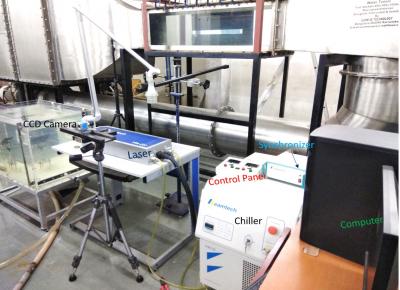
Particle image velocimetry (PIV) technique is used for measurement of fluid velocity. It involves seeding micron-size particles in a flow, illuminating the particles with a laser pulse, capturing the position of the particles using a camera, and finally interrogating two such time elapsed images to obtain the displacement (and velocity) of the particle (or flow). The technique provides information at numerous points simultaneously and is non-intrusive; these advantages make PIV score substantially higher than conventional techniques (such as Pitot tube). A PIV instrument has become a standard tool in a Fluid Mechanics lab.However, with cost of Rs30 lakhs onwards, it is a relatively costly instrument.In this context, we have assembled in-house a PIV instrument at one-third cost of a commercial system. The experience is being extended to develop a three-dimensional (3D-PIV) instrument; this includes development of an algorithm (which is being patented) to re-construct the 3D motion of particles in space. These advanced instruments allow probing turbulent and other
complex flows in unprecedented details. The PIV instrument has been used for studying wake interaction from multiple bodies arranged in V, row, and in-line configurations.
A dye-visualisation image of flow around six in-line square cylinders was highlighted on the cover page of Journal of Fluid Mechanics, which is the most prestigious fluid mechanics journal. Flow around corrugated and superhydrophobic hydrofoils have been mapped in great detail using this instrument, most of it for the first time. Such data aids in understanding
swimming / flying of individual and group of fishes / birds. PIV data for free / impinging jet / pulse jet has also been obtained to understand the high transfer removal capability of such flows. Several novel data analysis techniques based on PIV data: detection of turbulent / non-turbulent interface; turbulence spectrum from PIV data; detection of vortices and measuring their properties, have also been proposed.
Prof. Amit Agrawal
